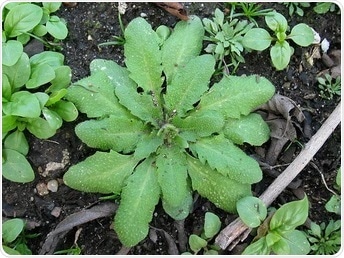According to a research recently published in the eLife journal, plants acquire unique defensive compounds through the collective effects of genes, demography, geography, and environmental circumstances.

Arabidopsis thaliana. Image Credit: Public Domain.
The results demonstrate a pattern in the forms of defense compounds produced by plants throughout Europe and also explain some of the evolutionary mechanisms that produce them.
Since plants are stationary species, they depend on the production of defense compounds known as specialized metabolites to ensure their survival. Structures of specialized metabolites vary greatly, including the number of carbon molecules and the other chemical groups that bind to those carbon molecules. Due to genetic variation caused by different evolutionary processes and events over time, each plant under each environment has a distinct profile of specialized metabolites.
We already know that environmental pressures such as the type of herbivores that prey on plants influences the specialized metabolites plants produce. We wanted to understand how the intersection of environmental pressure, demography and genomic complexity gives rise to the pattern of metabolic variation across a plant species.”
Ella Katz, Study First Author and Postdoctoral Researcher, Department of Plant Sciences, University of California, Davis, US
To do this, the researchers quantified the variation in specialized metabolites across a population of nearly 800 seed samples of the plant species Arabidopsis thaliana (A. thaliana), a form of cress, collected from across Europe.
The researchers looked at three regions in the plant genome known to affect the survival fitness of A. thaliana and also across the whole genome to identify genes associated with metabolite production. They subsequently combined each gene into groups that represent different types of specialized metabolites, known as chemotypes.
This enabled the researchers to determine which chemotypes were more prevalent in various parts of Europe and identify specific geographic patterns. For instance, chemotype variability was high in Central Europe and areas of Northern Europe, like Poland and Germany. However, throughout southern Europe including Italy, the Iberian Peninsula, and the Balkans, there were two distinct chemotypes that were clearly geographically isolated.
The researchers next investigated if these regional variations in chemotypes were related to landscape and weather conditions. They assigned an environmental value to each gene depending on its location, such as rainfall in the driest and wettest months, distance to the coast, and temperature of the coldest and warmest months.
The researchers also assigned the genes as Southern or Northern depending on their proximity to the Alps, Pyrenees, or Carpathian Mountain ranges. By using the most commonly found chemotypes, they demonstrated that environmental conditions had varied relationships to the chemotypes that change by geographical location.
This implies that the association between specialized metabolites and environmental circumstances differs across different parts of Europe; therefore, even if wetter weather was associated with a certain chemotype in Southern Europe, it was not the same in Northern Europe.
Finally, the researchers investigated how these genes evolved over time. Gene characteristics can evolve either separately within a species, a process known as convergent evolution, or by parallel evolution, in which species respond to analogous environmental stimuli in a comparable manner. They discovered that the evolution of genes at the three most prevalent genome sites was affected by a combination of events reminiscent of either convergent or parallel evolution.
Furthermore, the presence of difference at each of the three sites contributes to shaping the evolution of other genes. This is probably because the effects of varied specialized metabolites may work with or against one another to help the plant survive.
Our work provides a new perspective on the complexity of the forces and mechanisms that shape the generation and distribution of specialized metabolites and affect the plant’s ability to survive in a changing environment. Using a larger plant population from other locations around the world will enable us to deepen our understanding of the evolutionary mechanisms that determine the variation in a population.”
Daniel Kliebenstein, Study Senior Author and Professor, Department of Plant Sciences, University of California, Davis
Kliebenstein also works in DynaMo Center of Excellence, University of Copenhagen, Denmark.
Source:
Journal reference:
Katz, E., et al. (2021) Genetic variation, environment and demography intersect to shape Arabidopsis defense metabolite variation across Europe. eLife. doi.org/10.7554/eLife.67784.